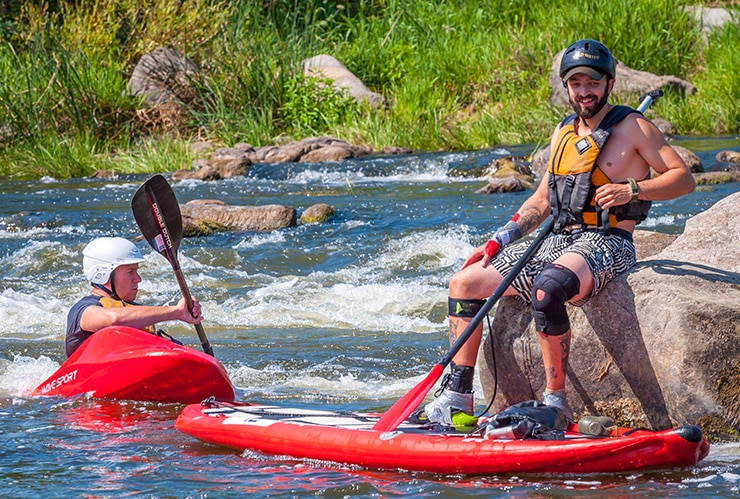If you’re new to the world of watersports, there’s probably a question that’s popped up in your head or time or two: is paddle boarding harder than kayaking?
Both kayaking and paddle boarding are comparable sports, with each requiring similar skills. However, the nature of how you use your body and vessel differs. Because of this, paddle boarding is generally easier than kayaking.
Paddling on a SUP comes with a much less intensive learning curve. Plus, the benefits can be substantially greater than those you’ll encounter on a kayak.
Kayaking vs Paddle Boarding: What’s the Difference?
There are both visible and invisible differences between kayaking and paddle boarding. The way you move your body, the different muscle groups you use, and how much effort you exert changes depending on whether you’re on a kayak or a SUP.
Let’s take a look at what these differences are and why they make paddle boards much easier to paddle than kayaks.
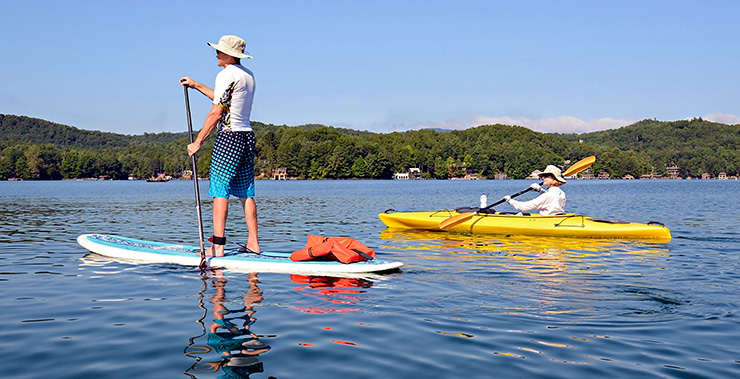
How Are Paddle Boards Different From Kayaks?
The first obvious difference between paddle boards and kayaks is the fact that a paddle board involves standing, while a kayak requires you to be seated.
Unless you’re doing some hardcore fishing or are getting ready to dive into the water, you won’t ever need to stand up while kayaking.
Much like a SUP board, there are different types of kayaks to choose from. You could opt for an inflatable kayak or a hard shell, a fishing kayak, or even a paddle board kayak hybrid (although these can more closely resemble paddle boards).
While most kayaks are single seaters, you can also double – with two kayak cockpits positioned one behind the other, for a tandem paddling experience.
The style of seating varies among kayaks too – from sit in kayaks to sit on top, to closed and open kayaks. Different styles of kayaks require different skills and can be harder or easier to operate based on your experience.
Unlike kayaks, stand up paddle boards require you to stand a majority if not the entire time you’re on the board. You can certainly sit down if you want to take a break and relax, but paddling while sitting is not the most effective way to use this type of vessel.
Kayaking and Paddling Use Different Skills and Muscle Groups
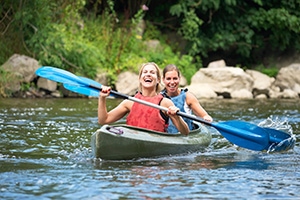
The skills you need, and the muscle groups you’ll be working out will also differ between kayaking and paddle boarding.
Because kayaks require you to sit, you’ll be using a lot of upper body strength to push the paddle along. Your legs won’t be doing much work unless you’re pushing against your kayak’s foot pedals or against the hull in order to create tension. This tension allows you to balance better for when you hit rough currents.
Paddling on a SUP, however, offers a full body workout. Stand up paddle boarding requires upper body, core, and lower body strength. Your calves will have quite a bit of a work out because balancing is essential when you’re on a paddle board.
You can change your paddling technique and paddle in a kneeling position to take some of the strain off, but for the most part you will be working your entire body.
On a kayak, you’ll mainly be working out your shoulders, triceps, and back muscles. When you’re on a paddle board, expect to engage all of your upper body muscles including your core, your quads, and your calves.
Is Paddle Boarding or Kayaking Easier?
The very nature of a paddle board’s design, the skills required, and the muscle groups that are engaged all make going out on a paddle board much easier than a kayak.
When you try both paddle boarding and kayaking, you’ll also find that being on a SUP paddle board offers you the most control. This will help you build your confidence while on the water making the sport that much more enjoyable.
Why is Paddle Boarding Easier Than Kayaking?
While it might not seem like it at first, especially if you’ve never done it before, paddle boarding is easier than kayaking – and it’s so much fun!
If you ensure you’re using a good paddle board with the correct board length and width for your size, it’ll only take a little practice before you’re taking off on paddling excursions. Let’s take a look at some of the main reasons why.
Kayaking Has a Steeper Learning Curve Than Paddle Boarding
There are a couple of skills you have to master before you can successfully start kayaking.
Kayaking first requires you to be able to balance yourself so that you can board and eventually disembark from your kayak. A lot of first-time kayakers struggle with knowing how to launch their kayak and then board it properly.
Once you do get on board, you’ll need to understand how to position yourself so that you’re not only comfortable but stable.
This is not the same with paddle boarding. It’s easier to get onto a paddle board that a kayak, and you can even do so from the shore
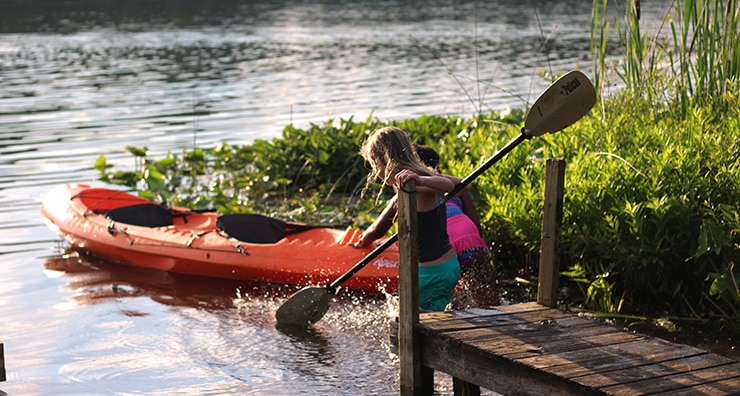
It is Easier to Board (and Disembark) a Stand Up Paddle Board
As stated, it’s easier to get onto a paddle board that a kayak, and you can even do so from the shore
Being on a SUP requires many of the key skills used in surfing. When you board a paddle board, it’s simple enough. Your goal is to get on your board, preferably in a sitting position at first, and then standing.
Even if you have never surfed, you’ll find it’s rather easy to maneuver a paddle board and hop on it.
Once you’re on a paddle board, it’s best to start off by sitting. Sitting allows you to get a sense of how your movements control the board. This will help you develop the balance you need to stay upright.
Disembarking from a paddle board it’s pretty straightforward as well. Unlike a kayak where you have to paddle to shore and then carefully disembark, you can simply hop off of your paddle board and then pull it back with you to shore.
You Can Learn SUP Basics in a Few Hours
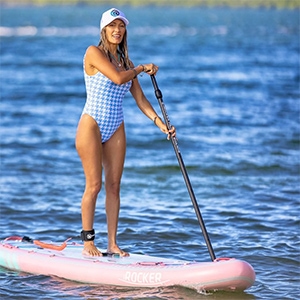
At its core, Using a stand up paddle board consists of knowing how to balance and knowing how to paddle. You can pick up both these skills pretty quickly in just a couple of hours.
The nature of paddle boarding also makes it an easier sport to learn. Because you can stand on a paddle board, you’ll have greater control over your body and greater control over your balancing ability.
You don’t have to have a great sense of balance to properly stand, especially if you use a stable SUP.
Unlike surfing, where it can be tricky to stand, paddle boards are usually wider. This provides more than enough surface area so that balancing is not a difficult feat.
Once you have the hang of balancing, it will take a couple of goes to feel comfortable paddling while you stand. Once you have these two skills down, it’s all about perfecting the way you paddle board.
Kayaking Can Be More Physically Demanding Than Paddle Boarding
One of the downsides of kayak paddling is that you’re likely to exert a lot more effort than you would paddle boarding. This goes for both on the water and off the water.
For starters, transporting a kayak is often a two-man job. Unloading your kayak from your vehicle and carrying it down to the shore can be cumbersome and physically demanding. When it’s time to get out, drying up your kayak and loading it back into your vehicle can be equally taxing.
Once you are in the water, you’ll be restricted in the way you can move. Unless you’re out kayak fishing, you’re going to be parked in your kayak seat nearly the entire time when you’re on a kayak.
While this might sound like a relaxing break to be on your kayak seat the entire time, it’ll take a toll. As you continuously row with your kayak paddle, your shoulders, back, and arms will be constantly engaged.
If you are a first time kayaker, this constant stress on your upper body can be incredibly physically demanding.
While being on a stand up paddle board requires you to use a lot more muscle groups, it’s surprisingly less physically demanding than kayaking. This is because you have the ability to give your body a break throughout your paddle boarding session.
You’ll also be able to give different parts of your body a break while engaging other parts. You can switch from sitting, to standing, to even lay down on your paddle board whenever you need to take a break.
Do Kayaking and Paddle Boarding Require the Same Skills?
From a basic standpoint, kayaking and being on a paddle board use many of the same skills as I mentioned above. When you switch up the type of stand up paddling or kayaking you do, that’s when you’ll discover that different skill sets are required with each type of activity.
Let’s take a look at some of the basic skills that are found in both kayaking and stand up paddle boarding. We’ll also talk a bit about how each skill differs whether you’re on a SUP or a kayak.
Both Kayaking and Paddle Boarding Require Good Balance
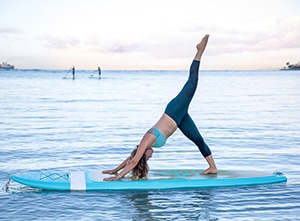
Balance is key with both kayaking and paddle boarding.
When it comes to a paddle board vs kayak, the type of balancing required does differ a bit in terms of which muscle groups will be engaged.
When you’re on a stand up paddle board, you’re going to mostly use your core and leg muscles to maintain your balance. Of course, your upper body will also help you with balance in the way you maneuver your paddle in and out of the water.
Generally speaking, however, when you’re in a standing position on your SUP, you’ll have the ability to move your body. This gives you the freedom to position yourself in a way that feels most comfortable for you to balance.
For paddle boarders who are really struggling with standing up and keeping their balance, you’ll have the advantage of being able to sit on your knees.
Being in a seated position allows you to build up confidence in your ability to control the SUP before you move to standing up entirely.
When you’re balancing on a kayak, you’re going to be losing a lot more of your upper body strength to maintain your balance. A big part of this is knowing how to move your kayak paddle so that you don’t tip the kayak too much to one side.
A major downside to balancing while on a kayak is that you’ll be using a lot of upper body strength to keep your balance. This overexertion of your upper body can leave you feeling sore and tired, especially during long adventures.
Kayaking and Paddle Boarding Both Require Upper Arm Strength
You’re going to be working out your upper body on both a kayak and stand up paddle board. When you’re on a stand up paddle board, your upper body is engaged when you paddle, and when you work on keeping your balance.
Luckily, paddle boarding offers you the advantage of being able to change your position and the way you stand so that you can alleviate some of that stress on your upper body.
Kayaking also requires upper body strength, but it’s more physically demanding than on a stand up paddle board. You won’t be using your feet to help you keep balance or provide power, so a lot of the physical exertion will come from your shoulders, back, and arms.
You May Need a Stronger Core for SUP than for Kayaking
When you are on a stand up paddle board, it’s almost a guarantee that you’ll get the ultimate ab workout. Paddle boarding is unique in that it engages your core in several different ways.
When you’re standing in a forward position and paddling from side to side, the pushback you get every time you tread water using your paddle allows you to engage your transverse abdominal muscles.
These muscles are the deep core muscles that impact the overall foundation of your core. Building up these muscles also helps you improve your stability, balance, and control.
The way you stand on a paddle board also indirectly engages your core. Balancing, controlling the position of your body, and constantly adjusting for stability all helps to improve your core.
SUP Requires Better Balance
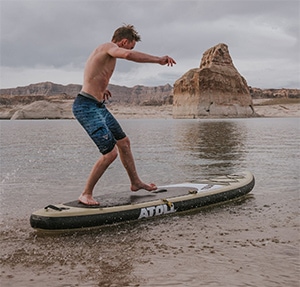
While kayaking requires some semblance of balance, you’ll really want to refine that skill when it comes to paddling on a SUP. The good news is that there are different ways to help improve your balance when you’re on a paddle board.
Most paddle boards, provided they are from reputable brands, are pretty stable – as the recreational paddling market wouldn’t even exist if SUP was too difficult.
The easiest way to improve your balance on a SUP is by paddling in a kneeling position. This will give you a feel for the paddle board and allow you to build up your confidence. Enrolling in a SUP course is also a great way to improve your balance.
These courses are designed to help you maintain your control and composure when you’re on a board so that you feel confident in your paddling and overall balancing abilities.
Lastly, if you’re finding that it’s very hard to balance while you’re on your SUP, it’s likely because you need to strengthen your core a bit more. Engaging in core building exercises while you’re on dry land is a great way to prepare yourself and help you build core stability.
Is Kayaking or Paddle Boarding a Better Workout?
Whether you’re on a kayak or paddle board, you can expect to burn some serious calories. Paddle boarding is one of the most accessible water sports for a great workout. There are many reasons for this.
Paddle Boarding Gives You a Full Body Workout
From your arm muscles, to your core, to your legs, getting on a paddle board is the best way to work out your entire body.
PAddle boarding requires you to engage all parts of your body as you adjust to the board beneath you. You simply can’t stay still on a paddle board or else you’ll lose your balance and fall off.
For water lovers looking to engage almost every muscle group in their body, getting on a paddle board or even trying out some SUP yoga, is the best option.
Paddle Boarding is a Great Way to Build Endurance
Because paddle boarding works out your entire body, it’s also the best way to build endurance.
It’s easy to get in a moderate cardiovascular workout thanks to the physical demands on all parts of your body while on a paddle board. The more you get your heart pumping, the better your endurance will get too.
Is Kayak or Paddle Boarding Harder on the Back?
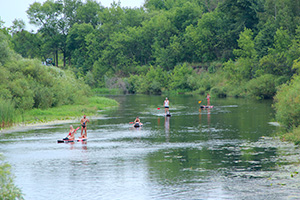
For the most part, paddling on a SUP is much easier on your back than paddling on a kayak.
Kayaking requires you to maintain a sitting position where you’re constantly putting pressure on your back, shoulders, and arm muscles to push the kayak forward.
Over time, this repetitive strain on your back muscles can cause back pain that will begin to pop up towards the end of your kayaking adventure. If you kayak on a regular basis, this pain might continue even when you’re out of the water!
Kayaking is also demanding on your back when it’s time to load and unload the kayak on your vehicle. Kayaks, even inflatable kayaks, can be a lot heavier and more cumbersome to transport than paddle boards. This makes them a literal backache when you move them from location to location.
Paddle boarding uses the same upper body muscle groups as kayaking, but you have the advantage of moving around and stretching your body. When you’re on a paddle board, you can shift your position and the way you stand so you can alleviate some of the stress in your back.
Is Kayak or Paddle Boarding Harder on the Knees?
One advantage that kayaking often has over paddling is knee strain. When you’re kayaking, you won’t be causing as much stress to your knees as you would if you were paddle boarding. For the most part, your legs will stay stationary when you kayak, making it a great sport for those who have knee pain or previous knee injuries.
Certain kayak designs will allow you to push back against the hull of the kayak with your knees. Constant tension on your knees can cause some knee strain, but not to the extent that it will cause you a problem.
Still, this doesn’t mean that if you’re someone who suffers from knee pain, paddle boarding isn’t for you. It’s quite the opposite actually. Take it slow on a paddle board and try out alternative poses that don’t cause so much stress to your knees.
Is Paddle Boarding Safer Than Kayaking?
Both kayaking and paddle boarding are relatively safe sports, regardless of if you’re using hardshell or inflatable boards and kayaks. Still, your skill level, preparedness, and ability to swim will all factor into how safe you will be when you’re on a paddle board or on a kayak.
Safety On a Kayak
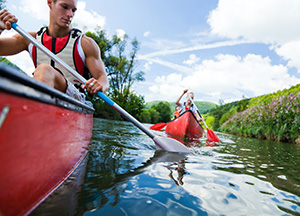
When you’re on a kayak, it’s imperative that you have a properly fitted life jacket, and you are seated in a proper position. If you put too much weight on either the front, back, or side of the kayak, you could risk tipping over into the water.
The type of kayak you have can also impact safety. Closed kayaks which feature a skirt along the opening and fit snugly around your waist can be unsafe for inexperienced kayakers.
If your kayak tips over, you’ll need to know how to maneuver yourself so that you can flip yourself upright again. Otherwise, it can be dangerous and even fatal because trying to escape from a closed cover kayak is difficult if you don’t know what you’re doing.
If you are in an open top, sit-in kayak, it’s much easier to eject yourself from the boat if it were to tip over.
The construction of your kayak also matters when it comes to safety. Hard shell kayaks are more resistant to punctures, scrapes, and leaks, making them safer options for inexperinced kayakers.
Still, with today’s level of technology, you’ll find plenty of inflatable recreational kayaks that are just as durable. You just need to be a little bit more careful in maintenance and operation so that you avoid punctures and scratches.
Safety On a Paddle Board
When you’re on a paddle board, your level of safety largely depends on your ability to swim and whether or not you’re wearing a properly fitted personal flotation device.
It’s imperative that if you paddle board, you have a basic understanding of how to swim. Unlike a kayak, you should expect to fall off your paddle board several times when you’re out on an adventure.
It’s recommended that you paddle board in water that is neck deep or deeper so you can avoid injury when you fall off your board. Because of this, it’s important to know how to swim so that you can safely swim back to your board and climb back on it.
If you’re concerned about safety and want to minimize the number of times you fall off of your board, focus on the board you have. Shopping for an inflatable paddle board will offer you more stability than a hard shell board. It’ll also help to opt for SUPs with wider bases and longer front edges.
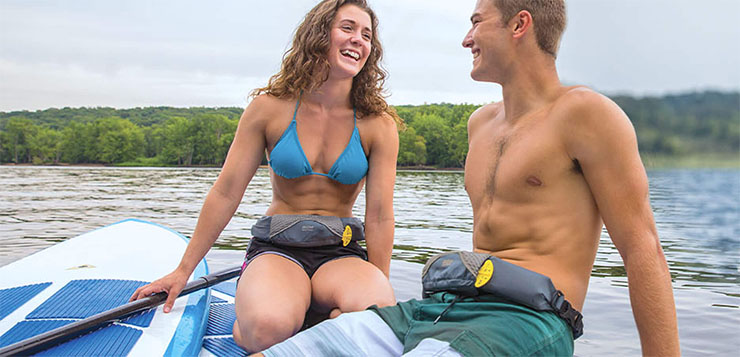
Final Thoughts: Is Kayaking Easier Than Paddle Boarding?
While both kayaking and paddle boarding are great sports, paddle boarding is easier than kayaking. Whether you use a traditional hardshell or an inflatable paddle board, you’ll find it’s easier to learn, transport, and overall paddle with a stand up paddle board.
Along with being easier to use, the skills associated with paddle boarding are much easier to grasp. There isn’t a steep learning curve, and you’ll get a full body workout while you try to get the hang of it.
Over time, you’ll find yourself building up your endurance and strengthening up your balancing ability.
If you’re someone who enjoys both paddle boarding and kayaking, share which sport you think is easier in the comments below

